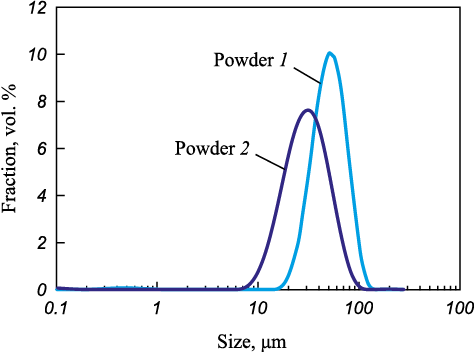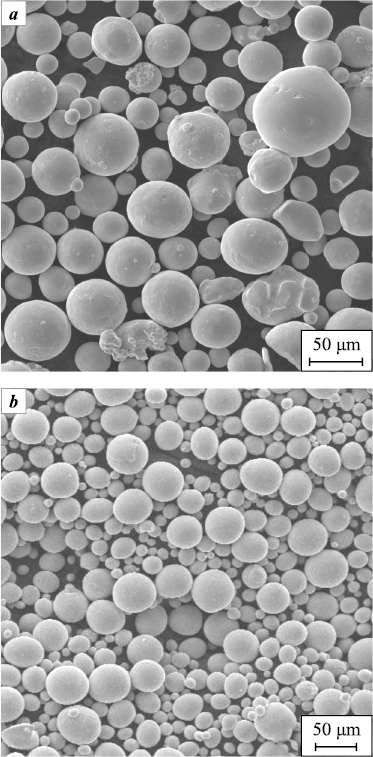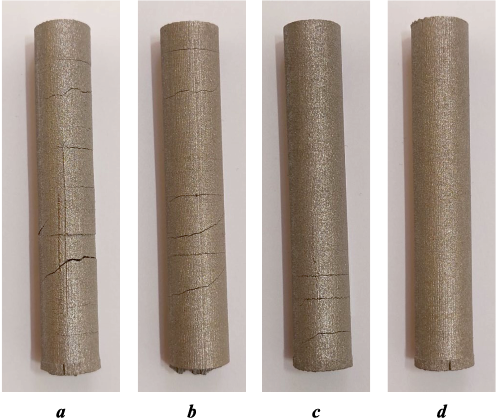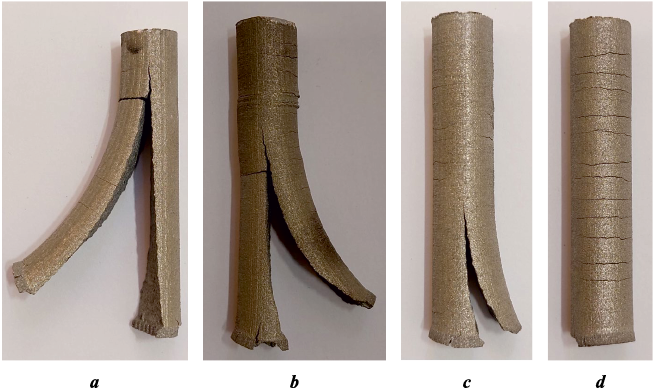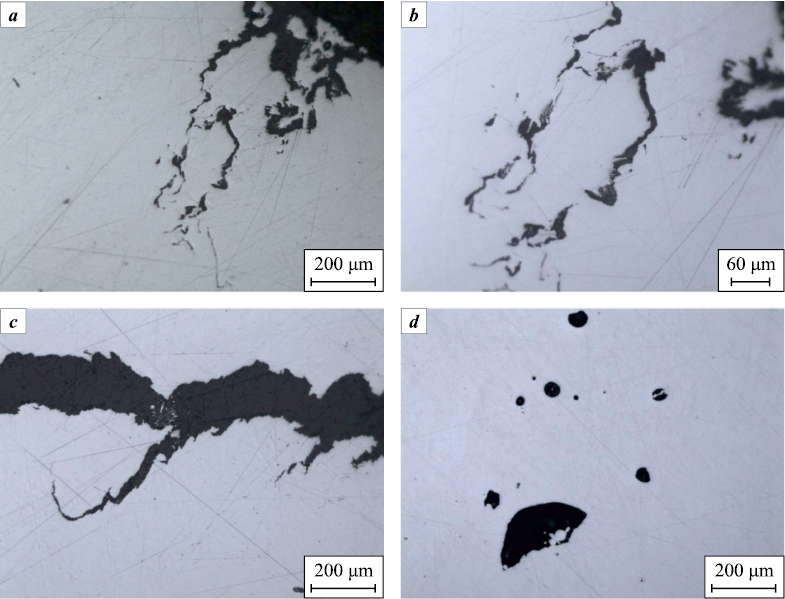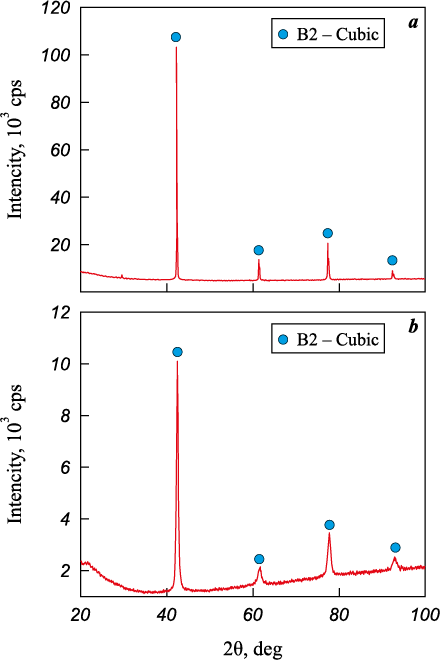Scroll to:
Features of obtaining TiNi alloy samples from commercial powders with high oxygen content using the SLM technique
https://doi.org/10.17073/1997-308X-2024-3-62-70
Abstract
Additive technologies, in particular selective laser melting (SLM), enable to manufacture the products with complex geometries. The SLM technique can help to effectively expand the titanium nickelide scope of application. However, SLM is a complex process – numerous factors significantly affect the characteristics of the resulting alloy. When the SLM technique is used, as the material is subject to laser processing, the content of nickel in the alloy drops due to evaporation, which can lead to changes in the temperatures of martensitic transformations. This impact on the resulting alloy characteristics can be regulated by changing the parameters of the SLM process. The objective of our research was to develop the processing methods for manufacturing samples from two commercial TiNi alloy powders using the SLM technique and to analyze the factors causing defects in the obtained samples. At the same time, processing methods with low values of volumetric energy density were used to reduce possible evaporation of nickel during printing. The initial powders were examined for the presence of impurities or other factors affecting the quality of the manufactured samples. The processing method A4 that we have developed for powder 1 enables to obtain a defect-free sample with the density of 6.45 g/cm3. It was found that none of the processing methods used enabled to obtain a defect-free sample from powder 2 due to presence of a large amount of oxygen impurities, including in particular Ti4Ni2Oх secondary phase, which leads to embrittlement and destruction of the samples. Therefore, high content of oxygen in the initial powders has a negative impact on the quality of the samples manufactured using the SLM technique.
Keywords
For citations:
Farber E.M., Borisov E.V., Popovich A.A. Features of obtaining TiNi alloy samples from commercial powders with high oxygen content using the SLM technique. Powder Metallurgy аnd Functional Coatings (Izvestiya Vuzov. Poroshkovaya Metallurgiya i Funktsional'nye Pokrytiya). 2024;18(3):62-70. https://doi.org/10.17073/1997-308X-2024-3-62-70
Introduction
Titanium nickelide (TiNi) is one of the most well-known smart materials famous for superelasticity and its ability to exhibit shape memory effect. It is widely used in the aerospace and automotive industries, medicine, microelectronics and other fields of science and technology [1–5]. Additive technologies, in particular the selective laser melting (SLM) method, enable to create highly complex geometries [6] and can dramatically increase applications of titanium nickelide. However, SLM is a complex process – numerous factors significantly affect the characteristics of the resulting alloy.
It is known that when the SLM technique is used for laser processing of the material, the nickel content in the alloy drops due to evaporation as the boiling points of nickel and titanium differ: nickel boils at 2913 °C, while titanium has a boiling point of 3287 °C [7–12]. Additionally, nickel has a higher partial pressure than titanium, and therefore nickel is more volatile at elevated temperatures [7]. It has been established that changes in the nickel content in the alloy can result in changing temperatures of martensitic transformations – the main parameters indicating that the functional properties of the alloy can manifest themselves at certain temperatures [13–15].
This impact on the resulting alloy characteristics can be regulated by changing the parameters of the SLM process – volumetric energy density (E) and its determining factors – scanning speed, distance between laser passes, laser power and layer thickness. It was found that as the E value increases, so does nickel evaporation during the SLM process [16–18]. Some researchers point out that an average volumetric energy density of more than 100 J/mm3 is required to obtain dense products from nitinol using the SLM technique [3; 18–20]. At the same time, in some studies, defect-free samples were obtained with lower E values [11; 21; 22]. Such a spread in the values of volumetric energy density may indicate that the quality of the initial powder (presence of impurities or secondary phases in it) affects the characteristics of the resulting products.
Based on the above, the objective of our research was to develop the processing methods for manufacturing samples from two commercial TiNi alloy powders with enhanced oxygen content using the SLM technique and to analyze the factors causing defects in the obtained samples. At the same time, processing methods with low values of volumetric energy density were used to reduce the possible evaporation of nickel during printing [17]. The initial powders were examined for the presence of impurities or other factors affecting the quality of the manufactured samples. The results obtained will, in the future, enable to improve the quality of the resulting products and to simplify the selection of TiNi alloy powders, as well as the development of processing methods for manufacturing products from these powders.
Materials and methods
In this study, we used two commercially produced spherical powders (1 and 2, respectively) of TiNi alloy with similar chemical composition Ti49Ni51 (at. %). The chemical composition of these powders is presented in Table 1.
Table 1. Chemical composition (at. %) of the powders under study
|
The cylindrical samples with a diameter of 10 mm and a height of 60 mm were fabricated for the study. Table 2 shows 4 methods of their production using the SLM technique. The processing methods with low values of volumetric energy density – E < 100 J/mm3 – were selected to minimize nickel evaporation during the SLM process. The E values are changed by gradually reducing the scanning speed in increments of 175 mm/s. The laser power, distance between passes, and layer thickness remained the same for all processing methods. For convenience, the samples manufactured using a certain processing method from powder 1 will hereinafter be marked as A1/1, A2/1, A3/1 and A4/1, and those from powder 2 – A1/2, A2/2, A3/2 and A4/2.
Table 2. Processing methods for manufacturing samples
|
The SLM process was conducted on the SLM280HL printer (SLM Solutions GmbH, Germany), which uses an ytterbium fiber laser with a maximum power of 400 W, has a wavelength of 1070 nm, the minimum laser beam diameter of 80 μm and the maximum scanning speed of 15 m/s. The process was implemented in an inert gas atmosphere (argon). The chemical composition of the initial powders and the resulting samples was visually analyzed and determined using Tescan Mira 3 LMU scanning electron microscope (SEM) (Tescan, Brno, Czech Republic) with an energy-dispersive X-ray spectroscopy module “EDX X-max 80” (Oxford Instruments, Abingdon, United Kingdom). The microstructure of the obtained samples was evaluated on a Leica DMI 5000 light optical microscope (Leica Microsystems, Germany). The granulometric composition of the powders was assessed using an Analysette 22 NanoTec particle size analyzer (Fritsch, Germany). The phase composition of the initial powder and the resulting samples was determined on a Bruker D8 Advance X-ray diffractometer (Bruker, Bremen, Germany).
Results and discussion
Fig. 1 shows the granulometric composition of the powders under study. Volume distribution fractions for powder 1 – d10 = 28.7 µm, d50 = 48.1 µm, d90 = 76.5 µm, for powder 2 – d10 = 15.1 µm, d50 = 29 µm, and d90 = 52.6 µm.
Fig. 1. Granulometric composition of the powders under study |
Fig. 2 demonstrates SEM images of the powders under study.
Fig. 2. SEM images of the powders used |
Fig. 3 shows the samples made from powder 1 using various processing methods; Fig. 4 demonstrates the samples from powder 2. In Fig. 3, we see that the samples manufactured at a lower volumetric energy density (A1/1, A2/1) have multiple defects in the form of cracks. As E was increased by reducing the scanning speed, first, the number of visually detectable cracks (sample A3/1) decreased, and as E reached 90 J/mm3 (sample A4/1), no cracks were detected by visual inspection. The density of the resulting sample A4/1 was 6.45 g/cm3. The nickel content in the defect-free sample A4/1 (50.85 at. %) dropped by 0.18 at. % against the original powder 1. The results of our study are generally consistent with those previously obtained in [17].
Fig. 3. Samples made from powder 1
Fig. 4. Samples made from powder 2 |
The samples from powder 2, which were manufactured using processing methods with low volumetric energy density, are severely deformed and partially destroyed (see Fig. 4). The increase in E resulted in a decreased level of deformation; however, even at E = 90 J/mm3 (sample A4/2), multiple cracks were observed along the entire length of the sample.
The large number of cracks in the samples is associated primarily with the features of the SLM process, namely with residual stresses caused by a high temperature gradient during the samples manufacture due to rapid heating, melting and, subsequently, rapid cooling and solidification of the material, as well as possible presence of defects in the form of micropores [23–25]. An increase in the scanning speed during the samples manufacture causes an expected drop in volumetric energy density. When the energy density is insufficient, micropores and discontinuities emerge in the sample structure due to the small size of the molten bath and presence of unmelted powder particles [3]. These defects are stress concentrators that contribute to active propagation of cracks in the samples. This phenomenon was observed in the samples made from powder 1. When the processing method A1 was used with a scanning speed of 1450 mm/s, a large number of cracks was registered over the entire area of the sample; and when the scanning speed was reduced to 925 mm/s, cracks were not visually detected.
Fig. 5 shows the microstructure of samples from powder 2 with various defects. We can see multiple cracks at the edges of the sample (Fig. 5, a and b) and also the ones running through the entire sample (Fig. 5, c), up to 200 μm thick. In addition, spherical and non-spherical pores of various sizes (some larger than 100 μm) are visible. Some cracks penetrate through pores and propagate in them (Fig. 5, a and b).
Fig. 5. Defects in the samples made from powder 2 using the SLM technique |
The samples made from powder 2 underwent rather severe deformations, which is indicative of additional factors contributing to crack formation, along with the scanning speed. One of the hypothetic causes may be the presence of a large amount of oxygen in the initial powder 2 (more than in powder 1), which may also be present in the form of Ti4Ni2Ox secondary phase. In powder 2 under study, the oxygen content was initially 2 times higher than in powder 1. The Ti4Ni2Ox secondary phase is a Ti2Ni phase with oxygen in the solid solution. The presence of this phase has a negative impact on the alloy and can lead to embrittlement and destruction of samples [26; 27]. It was noted [28] that initially cracks emerge in this very Ti4Ni2Ox secondary phase. Therefore, a large amount of this phase in the composition of the initial powder can lead to increased cracking when the samples are manufactured. Another assumption is that a large amount of oxygen contributes to the formation of these secondary phases during the sample preparation process.
To determine the reasons more clearly, a cross-section of powder 2 was prepared. Fig. 6 shows SEM images of particles of powder 2 at high magnification. It is clearly visible that the particles contain dark inclusions, which may be Ti4Ni2Ox secondary phases.
Fig. 6. SEM image at high magnification |
Fig. 7 shows the results of X-ray phase analysis of powder 2 and a sample made from it.
Fig. 7. X-ray diffraction patterns |
The X-ray diffraction pattern of the sample (Fig. 7, b) shows that the lines of the B2 phase have widened severalfold compared to the original powder. This widening is attributed to increased dislocation density and micro stresses. No secondary phases were detected in the composition of either the powder or the sample. This may suggest an extremely low content of the indicated Ti4Ni2Ox phases in the composition of both powder 2 and the samples made from it – below the detection limit of the research method used. Moreover, as the lines of the B2 phase have widened, the coordinates of all the sought Ti4Ni2Ox lines (39.0, 41.4 and 45.2) lie at the (110) B2 peak base. It can be assumed that the sample contains the indicated Ti4Ni2Ox secondary phase, but its detection is hampered.
In general, based on the results obtained, we can confidently state that the increased oxygen content in the initial powder negatively affects the quality of the resulting samples, especially when they are manufactured with low values of volumetric energy density. To confirm this conclusion, we investigated the chemical composition of samples A4/1 and A4/2 for oxygen content. The results are presented in Table 3. It was found that the oxygen content in sample A4/2 reached 0.4 at. %, which is 0.14 at. % more than in sample A4/1. The oxygen level in the samples is higher than in the powder due to the capture of oxygen during the samples manufacture using the SLM technique. It can be noted that as the same processing method A4 was used, the oxygen content being high both in the original powder and in the manufactured sample, the sample from powder 1 had no defects, while that from powder 2 had numerous cracks. It confirms the assumption that oxygen content affects formation of defects in the samples manufactured using the SLM technique.
Table 3. Oxygen content in the samples
|
Conclusions
1. Having tested the processing methods, we came to conclusion that the defect-free sample from powder 1 can be obtained using the processing method A4. The density of the resulting sample A4/1 was 6.45 g/cm3. Defect-free samples from powder 1 cannot be obtained using the processing methods with lower volumetric energy density.
2. We failed to obtain a defect-free sample from powder 2 using any of the processing methods. Probably methods with higher values of volumetric energy density are required to obtain defect-free samples from this powder.
3. The presence of a large amount of oxygen impurities in powder 2 is one of the factors that hampered us to obtain defect-free samples when using the indicated processing methods. This is attributed to Ti4Ni2Ox secondary phase present in the powder composition, which leads to embrittlement and destruction of the samples. That is, the increased oxygen content in the initial powders negatively affects the quality of samples manufactured using the SLM technique.
4. The study of the microstructure of samples obtained from powder 2 revealed the presence of spherical and non-spherical pores and cracks of various sizes. It was found that cracks propagate directly through the detected pores.
References
1. Horvay K., Schade C. Development of nitinol alloys for additive manufacturing. In: Contributed papers from materials science and technology. USA, Ohio, Columbus: Greater Columbus Convention Center, 2018. P. 63–70. https://doi.org/10.7449/2018mst/2018/mst_2018_63_70
2. Borisov E., Starikov K., Popovich A., Tihonovskaya T. Investigation of the possibility of tailoring the chemical composition of the NiTi alloy by selective laser melting. Metals (Basel). 2021;11(9):1–11. https://doi.org/10.3390/met11091470
3. Chernyshikhin S.V., Pelevin I.A., Karimi F., Shishkovsky I.V. The study on resolution factors of LPBF technology for manufacturing superelastic NiTi endodontic files. Materials (Basel). 2022;15(19):6556. https://doi.org/10.3390/ma15196556
4. Chernyshikhin S.V. Panov D.V., Van Tuan T., Ozherelkov D.Y., Sheremetyev V.A., Shishkovsky I.V. Laser polishing of nickel-titanium shape memory alloy produced via laser powder bed fusion. Metals and Materials International. 2023;29(10):3024–3038. https://doi.org/10.1007/s12540-023-01432-8
5. Dadbakhsh S., Speirs M., Kruth J.P., Van Humbeeck J. Influence of SLM on shape memory and compression behaviour of NiTi scaffolds. CIRP Annals. 2015;64(1): 209–212. https://doi.org/10.1016/j.cirp.2015.04.039
6. Ehsan Saghaian S. Nematollahi M., Toker G., Hinojos A. Effect of hatch spacing and laser power on microstructure, texture, and thermomechanical properties of laser powder bed fusion (L-PBF) additively manufactured NiTi. Optics & Laser Technology. 2022;149:107680. https://doi.org/10.1016/j.optlastec.2021.107680
7. Elahinia M., Moghaddam N.S., Andani M.T., Amerinatanzi A., Bimber B.A., Hamilton R.F. Fabrication of NiTi through additive manufacturing: A review. Progress in Materials Science. 2016;83(12):630–663. https://doi.org/10.1016/j.pmatsci.2016.08.001
8. Farber E., Zhu J-N., Popovich V.A. A review of NiTi shape memory alloy as a smart material produced by additive manufacturing. Materials Today: Proceedings. 2020;30: 761–767. https://doi.org/10.1016/j.matpr.2020.01.563
9. Jalali M., Mohammadi K., Movahhedy M.R., Karimi F., Sadrnezhaad S.K., Chernyshikhin S.V., Shishkovsky I.V. SLM additive manufacturing of NiTi porous implants: A review of constitutive models, finite element simulations, manufacturing, heat treatment, mechanical, and biomedical studies. Metals and Materials International. 2023;29(9):2458–2491. https://doi.org/10.1007/s12540-023-01401-1
10. Kai W.Y., Chang K.C., Wu H.F., Chen S.W., Yeh A.C. Formation mechanism of Ni2Ti4O in NiTi shape memory alloy. Materialia. 2019;5:100194. https://doi.org/10.1016/j.mtla.2018.100194
11. Kang G., Song D. Review on structural fatigue of NiTi shape memory alloys: Pure mechanical and thermo-mechanical ones. Theoretical and Applied Mechanics Letters. 2015;5(6):245–254. https://doi.org/10.1016/j.taml.2015.11.004
12. Ma J., Franco B., Tapia G., Karayagiz K., Johnson L., Liu J., Arroyave R., Karaman I., Elwany A. Spatial control of functional response in 4D-printed active metallic structures. Scientific Reports. 2017;7(1):46707. https://doi.org/10.1038/srep46707
13. Mahmoudi M., Tapia G., Franco B., Ma J., Arroyave R., Karaman I., Elwany A. On the printability and transformation behavior of nickel-titanium shape memory alloys fabricated using laser powder-bed fusion additive manufacturing. Journal of Manufacturing Processes. 2018;35:672–680. https://doi.org/10.1016/j.jmapro.2018.08.037
14. Meier H., Haberland C., Frenzel J. Structural and functional properties of NiTi shape memory alloys produced by Selective Laser Melting. In: Innovative developments in virtual and physical prototyping: Proc. of the 5th Inter. Conf. on advanced research in virtual and rapid prototyping (Leiria, Portugal, 28 Sept.–1 Oct. 2011). London: CRC Press, 2011. P. 291–296. https://doi.org/10.1201/b11341-47
15. Melnikova M.A., Melnikov D.M., Kolchanov D.S. Selective laser melting: Application and formation features of three-dimensional structural engineering elements. Photonics Russia. 2017;(2):42–49. https://doi.org/10.22184/1993-7296.2017.62.2.42.49
16. Mentz J., Bram M., Buchkremer H.P., Stöver D. Improvement of mechanical properties of powder metallurgical NiTi shape memory alloys. Advanced Engineering Materials. 2006;8(4):247–252. https://doi.org/10.1002/adem.200500258
17. Mentz J., Frenzel J., Wagner M.F.X., Neuking K., Eggeler G., Buchkremer H.P., Stöver D. Powder metallurgical processing of NiTi shape memory alloys with elevated transformation temperatures. Materials Science and Engineering: A. 2008;491(1–2):270–278. https://doi.org/10.1016/j.msea.2008.01.084
18. Mohd Jani J., Leary M., Subic A., Gibson M.A. A review of shape memory alloy research, applications and opportunities. Materials & Design. 2014;56:1078–1113. https://doi.org/10.1016/j.matdes.2013.11.084
19. Parvizi S., Hashemi S.M., Asgarinia F., Nematollahi M., Elahinia M. Effective parameters on the final properties of NiTi-based alloys manufactured by powder metallurgy methods: A review. Progress in Materials Science. 2021;117:100739. https://doi.org/10.1016/j.pmatsci.2020.100739
20. Saedi S., Moghaddam N.S., Amerinatanzi A., Elahinia M., Karaca H.E. On the effects of selective laser melting process parameters on microstructure and thermomechanical response of Ni-rich NiTi. Acta Materialia. 2018;144:552–560. https://doi.org/10.1016/j.actamat.2017.10.072
21. Saedi S., Saghaian S.E., Jahadakbar A., Moghaddam N.S., Taheri Andani M., Saghaian S.M., Lu Y.C., Elahinia M., Karaca H.E. Shape memory response of porous NiTi shape memory alloys fabricated by selective laser melting. Journal of Materials Science: Materials in Medicine. 2018;29(4):1–12. https://doi.org/10.1007/s10856-018-6044-6
22. Safaei K., Abedi H., Nematollahi M., Kordizadeh F., Dabbaghi H., Bayati P., Javanbakht R., Jahadakbar A., Elahinia M., Poorganji B. Additive manufacturing of NiTi shape memory alloy for biomedical applications: Review of the LPBF process ecosystem. JOM: The Journal of the Minerals, Metals & Materials. 2021;73(12):3771–3786. https://doi.org/10.1007/s11837-021-04937-y
23. Song B., Zhao X., Li S., Han C., Wei Q., Wen S., Liu J., Shi Y. Differences in microstructure and properties between selective laser melting and traditional manufacturing for fabrication of metal parts: A review. Frontiers of Mechanical Engineering. 2015;10(2):111–125. https://doi.org/10.1007/s11465-015-0341-2
24. Wang X., Kustov S., Humbeeck J. Van. A short review on the microstructure, transformation behavior and functional properties of NiTi shape memory alloys fabricated by selective laser melting. Materials (Basel). 2018;11(9):1683. https://doi.org/10.3390/ma11091683
25. Zhang C., Ozcan H., Xue L., Atli K.C., Arróyave R., Karaman I., Elwany A. On the effect of scan strategies on the transformation behavior and mechanical properties of additively manufactured NiTi shape memory alloys. Journal of Manufacturing Processes. 2022;84:260–271. https://doi.org/ 10.1016/j.jmapro.2022.09.051
26. Zhang Y., Attarilar S., Wang L., Lu W., Yang J., Fu Y.
27. A review on design and mechanical properties of additively manufactured NiTi implants for orthopedic applications. International Journal of Bioprinting. 2021;7(2):1–28. https://doi.org/10.18063/ijb.v7i2.340
28. Logacheva A.I., Sentyurina Zh.A., Logachev I.A. Additive manufacturing technology responsible products from metals and alloys (review). Perspektivnye Materialy. 2015;5:5–15. (In Russ.).
29. Shtin V.I., Novikov V.А., Choynzonov Е.L., Marchenko E.S., Stakheyeva М.N., Kucherova Т.Ya., Menshikov K.Yu., Cheremisina О.V., Gribova O.V. Orbital wall reconstruction with titanium nickelide implants in cancer patients: characteristics of reparative processes and the potential for their management Voprosy Onkologii. 2023;69(2):259–267. (In Russ.). https://doi.org/10.37469/0507-3758-2023-69-2-259-267
About the Authors
E. M. FarberRussian Federation
Eduard M. Farber – Engineer of the Laboratory “Synthesis of new materials and structures”
29 Polytekhnicheskaya Str., St. Petersburg 195251, Russia
E. V. Borisov
Russian Federation
Evgenii V. Borisov – Cand. Sci. (Eng.), Leading Researcher of the Laboratory “Synthesis of new materials and structures”
29 Polytekhnicheskaya Str., St. Petersburg 195251, Russia
A. A. Popovich
Russian Federation
Anatoly A. Popovich – Dr. Sci. (Eng.), Professor, Director of the Institute of Machinery, Materials and Transport
29 Polytekhnicheskaya Str., St. Petersburg 195251, Russia
Review
For citations:
Farber E.M., Borisov E.V., Popovich A.A. Features of obtaining TiNi alloy samples from commercial powders with high oxygen content using the SLM technique. Powder Metallurgy аnd Functional Coatings (Izvestiya Vuzov. Poroshkovaya Metallurgiya i Funktsional'nye Pokrytiya). 2024;18(3):62-70. https://doi.org/10.17073/1997-308X-2024-3-62-70




